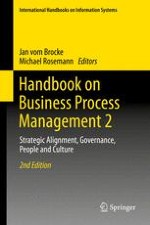2015 | OriginalPaper | Buchkapitel
Prioritizing Process Improvement: An Example from the Australian Financial Services Sector
verfasst von : Wasana Bandara, Alain Guillemain, Paul Coogans
Erschienen in: Handbook on Business Process Management 2
Verlag: Springer Berlin Heidelberg
Aktivieren Sie unsere intelligente Suche, um passende Fachinhalte oder Patente zu finden.
Wählen Sie Textabschnitte aus um mit Künstlicher Intelligenz passenden Patente zu finden. powered by
Markieren Sie Textabschnitte, um KI-gestützt weitere passende Inhalte zu finden. powered by
